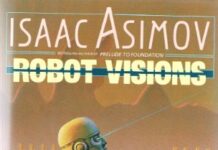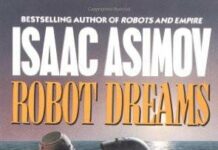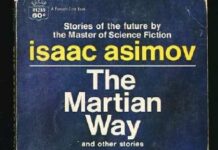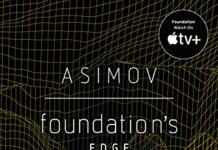
Ebook Info
- Published: 2012
- Number of pages: 405 pages
- Format: EPUB
- File Size: 0.34 MB
- Authors: Isaac Asimov
Description
The first of two prequel novels in Isaac Asimov’s classic science-fiction masterpiece, the Foundation seriesTHE EPIC SAGA THAT INSPIRED THE APPLE TV+ SERIES FOUNDATIONIt is the year 12,020 G.E. and Emperor Cleon I sits uneasily on the Imperial throne of Trantor. Here in the great multidomed capital of the Galactic Empire, forty billion people have created a civilization of unimaginable technological and cultural complexity. Yet Cleon knows there are those who would see him fall—those whom he would destroy if only he could read the future. Hari Seldon has come to Trantor to deliver his paper on psychohistory, his remarkable theory of prediction. Little does the young Outworld mathematician know that he has already sealed his fate and the fate of humanity. For Hari possesses the prophetic power that makes him the most wanted man in the Empire . . . the man who holds the key to the future—an apocalyptic power to be known forever after as the Foundation.
User’s Reviews
Reviews from Amazon users which were colected at the time this book was published on the website:
⭐”Why, he wondered, did so many people spend their lives not trying to find answers to questions—not even thinking of questions to begin with? Was there anything more exciting in life than seeking answers?”After five novels spanning as many centuries, one might have supposed Asimov’s stepwise tinkering with his Foundation universe had come to an end. The adventures of Golan Trevize, Janov Pelorat, and Bliss concluded in Foundation and Earth (1983), with a finale as intellectually rewarding as it was thematically resonant. Trevize gained the validation he desired for choosing Gaia (or proto-Galaxia) over the Seldon Plan. But just five short years later, again at the behest of avid fans and pushy publishers, Asimov picked up the series once more, this time in the form of a prequel. As its name suggests, Prelude to Foundation (1986) was the first of two prequels setting up the events of the original Foundation novel released in 1951.For most of the series, psychohistory’s founder, Hari Seldon, is this enigmatic figure spoken of only in cryptic, quasi-spiritual terms, rather like a demigod. Little is known about the man other than that he was a mathematical genius whose equations helped shepherd humanity through a series of increasingly existential crises. In Prelude Seldon’s saintly aura is stripped away as we are introduced to the young, martial arts-trained professor laboring to turn his coveted psychohistory into a practical, applied science.The first act opens on the planet Trantor, the Empire’s capital, as Dr. Seldon presents his seminal paper at the Decennial Mathematics Convention. In a decision he soon comes to regret, he lays out a theoretical method by which the future can be determined probabilistically. The key word here is ‘theoretical’, a detail those with a hankering for control over the world order seem uniformly disposed to overlook. In Seldon’s own words:”And I went on to show that this would result in the ability to predict future events in a statistical fashion—that is, by stating the probability for alternate sets of events, rather than flatly predicting that one set will take place.”News of his work spreads like a thunderbolt. Emperor Cleon I himself arranges a meeting, in the hope that he can use Seldon’s abilities as a means toward self-preservation. Haunted by the specter of assassination, Cleon is dismayed upon learning that psychohistory is not yet ready for primetime. He’s not about to risk it falling into the hands of his enemies, however, and orders his right-hand man, First Minister Eto Demerzel, to keep close tabs on Seldon’s progress. Demerzel is a shadowy character whose influence penetrates each of the disparate sectors on Trantor. Seldon now has a target on his back. Indeed, it seems he is now the most important person in all of the Galaxy, with the powers that be all wishing to profit from a mature psychohistory.Before Seldon can return to his home world of Helicon, he runs into one Chetter Hummin, an intrepid journalist who warns Seldon of the Emperor’s intentions. Like Cleon, Hummin also seeks a functional psychohistory. His aims prove more noble than the former’s, as he anticipates it being used to divert the Empire from its path of rotting decay. Seldon, meanwhile, harbors strong doubts that his mathematics actually possess the potential his benefactors so eagerly seek, but Hummin is able to convince him that his research will be for the good of humanity. After dispatching a couple of the Emperor’s goons, they flee to a nearby university in Streeling Sector, where Seldon can tend to his work in relative safety.There he meets Dors Venabili, a historian and the second protagonist in this outing. She agrees to watch over Seldon and assist him with his studies. Dors’ larger role in the narrative is shrouded in mystery and isn’t fully explored until the second prequel. In this outing she serves as an eloquent sounding board for Seldon’s frequent riffs and ruminations, while her strong-willed and circumspect presence nicely balance her counterpart’s impetuosity and fitful naivete over the course of their journeys. Thankfully for Seldon, she is also quite capable of kicking ass when only violent options present themselves.Seldon’s stint at the university is short-lived, as he is unable to escape the feeling that his every move is being watched by the Emperor and his minions. Following a close encounter in which Seldon’s reckless actions nearly get him killed, Hummin relocates Seldon and Dors to Mycogen Sector, an underground society on Trantor proper that is believed to possess some of the oldest records in the Galaxy. It is thought that by simulating an earlier period of history where the moving parts were decidedly smaller in both scale and in number, this will greatly simplify Seldon’s intractable task of mathematizing human societies.It wouldn’t be an Asimov novel without heaping sexism, and Mycogen serves it in spades. As thoroughly patriarchal as it is puritanical, Mycogen is a world in which the subservience of women has been raised to an organizing principle. In public, men speak only to men; women are never to address men, much less outsiders like Hari and Dors, outside the privacy of their own home. Seldon exploits the situation, manipulating one of the women to obtain their sacred book, hoping it may hold the clues he needs to perfect his theory. The book appears to be a dead-end, but it does lead Seldon to believe that the Mycogenians are protecting one big secret: a 20,000 year-old robot holed up in their Sacratorium—a museum-cum-temple of sorts dedicated to remembering their past glory on the home world Aurora.The site is off-limits to off-worlders, so Seldon and Dors don disguises and sneak inside. They do in fact find a robot, albeit defunct. In the process they are “caught” by one of the High Elders, an artificer whose machinations had lured the duo into a trap; rather than Seldon doing the manipulating, it was he who was beguiled into following a course of action pursuant to Mycogenian interests. The Elder had been in communication with the Emperor, and sought to strike a deal in turning Seldon over to Imperial authorities for his sacrilegious breach of custom. Seemingly always in the right place at the right time, Hummin intervenes by playing up psychohistory’s potential for furthering Mycogen’s interests. The Elder reluctantly agrees to forget the whole ordeal, reneges on his arrangement with the Emperor, and allows the trio to depart Mycogen for good. (Hmm…)Hummin shuttles them off to another of Trantor’s sectors known as Dahl. Not only is their purpose for going here unexplained, their stay in Dahl is one of the weaker sections of the book. Were it not for introducing important characters who play a larger role in the sequel, there would be little to recommend its place in the story. Seldon meets a precocious factory worker named Yugo Amaryl whom he promises a job after seeing some scribbled equations Amaryl had been working on in his spare time. Amaryl also mentions a wise woman known as Mother Rittah who holds ancient knowledge about Earth—the original home of humanity and, Seldon hopes, an ideal case study for psychohistory.Seldon and Dors venture into the slummy Billibotton District in search of Rittah, where they are set upon by a swarm of knife-wielding miscreants. Dors makes quick work of them, an experienced knife-fighter herself. Shortly thereafter they befriend a homeless, alley-smart twelve year-old named Raych who leads them to the oracle. She reveals to them that the Mycogenians’ lost world Aurora was actually the robot world that destroyed Earth (cue the Robot series!).Dahl authorities catch wind of their antics and send a pair of constables to question them. Threatened with arrest, Seldon and Dors knock out the officers, putting our heroes permanently on the run. Fortunately, Raych leads them to safety, when a mysterious soldier shows up on orders to escort Seldon away from Dahl. Raych, Dors and Seldon all end up in Wye—a sector at Trantor’s south pole—whose mayor (Rashelle) has been biding her time as she plots the usurpation of Emperor Cleon’s throne. Rashelle’s plan would allow her to gain full control of Trantor and its various sectors while relinquishing all Imperial command of the isolate planets. Seldon, she believes, is the ace in the hole required to carry out her grand act of sedition.Seldon wants no part in this scheme, and for good reason: he now knows how to make psychohistory practical. Through his diverse cultural experiences in each of the sectors spread across Trantor, he realizes Trantor itself will serve as the perfect model for developing his inchoate science, which can then be generalized to the rest of the twenty-five million worlds populating the Galaxy. At least, that’s the idea. But if Rashelle’s coup comes to fruition, the Galaxy would be plunged into anarchy, menaced by a neverending series of territorial disputes and sanguinary transfers of power. If Seldon is to mature his science and stave off the destruction to come, the Empire must remain at peace.As if on cue, Rashelle’s plot is foiled as the soldiers under her command no longer assent to her orders. Hummin arrives on the scene and the remaining pieces fall into place. We learn that Hummin is none other than…Cleon’s confidant and advisor Eto Demerzel. Moreover, he’s not actually a human at all, but the legendary robot named R. Daneel Olivaw, whom Trevize and crew meet in the conclusion to Foundation and Earth. Further still, Hummin / Demerzel / Olivaw possesses mentalic powers (à la the Mule) enabling him to subtly manipulate the emotions of others. This explains Seldon’s drive to perfect psychohistory despite his earlier skepticism, the High Elder’s leniency on Mycogen, and Rashelle’s failed scheme, among other improbable feats of chance.Having lived the last 20,000 years, Demerzel sees the approaching collapse of the Empire as inevitable and psychohistory as the mechanism by which to minimize the fallout. Thus, in accordance with the Zeroth Law—”A robot may not harm humanity, or through inaction, allow humanity to come to harm”—he intervenes just enough to nudge events in Seldon’s favor.Prequel FeverCritics have been somewhat harsh on this entry, and not without reason, the most fundamental perhaps being that Seldon’s quest for a workable psychohistory just isn’t all that compelling. What made the earlier novels so memorable was exploring the limits of psychohistory and seeing whether the next great challenge was acidic enough to dissolve the Seldon Plan. The cerebral acrobatics of navigating the contours of each successive crisis as the Galaxy tests its fate against the provisions of ancient prophecies forms the bread and butter of the Foundation series. Sure, Prelude contains all the twists and bombshell reveals characteristic of Asimovian fiction, but the humble beginnings of Seldon’s Big Idea fail to reach the epic heights imparted by the settings that have so endeared generations of readers.Delving too much into origins also comes at a cost. There’s a certain mystique surrounding psychohistory—one of the most inventive and successful concepts in all of science fiction—that isn’t helped by reductive exposition. By cutting the enormity of psychohistory down to size, some of the series’ allure invariably wisps away. More problematic is the lackluster execution of the reveal. There is no single ground-shaking discovery or torrent of insight that sets Seldon on the right path, no “Eureka!” moments that lead him to his statistical laws. He just wakes up one morning and says he’s worked it out. (No, literally that’s what happens.) We’re supposed to believe his traipsing around Trantor set him on the right course to a solution. That’s at best unsatisfying, even if it’s naive to expect juicy insights into what are ultimately fictional concepts with little chance of being mapped onto reality. But as plot devices go, it’s pretty tame.What’s more, the places they visit fail to inspire and feel thrown in merely to bridge Asimov’s various fictional projects. A lot of space in this book is tied up in external references to the Robot and Empire series—in asides that aren’t particularly purposeful in and of themselves. The robot subplot on Mycogen and the preoccupation with the Aurora-Earth connection, for example, make for interesting sync points with the Asimov corpus, but don’t do much heavy lifting in progressing the central plot of Prelude. Asimov notes in the introduction that unification was not what he had in mind when these stories were conceived, and devoted greater effort to the task later in his career. It certainly shows, but surely it’s not worth the confusion readers unfamiliar with his other stories are sure to experience.As for plot holes, there might be one relating to Olivaw. He has supposedly functioned as Demerzel, counselor to the Imperial throne, for decades, and is frequently referred to as the most influential person in the Galaxy, even more so than Cleon himself. He has connections with sectors all across Trantor. Yet no one knows what he looks like, or that Hummin and Demerzel are the same person? Or, rather, is it that Olivaw lulls them into forgetfulness? With the mind control mechanic, one can never be sure. (I had the same issue with Jessica Jones, alas.)There is also the obligatory caveat about character development. As we’ve come to accept from this series (and from Asimov in general), the individuals on the page serve largely as mouthpieces for Asimov’s ever active, idea-saturated mind. What ‘development’ we do get is intellectual in nature, as Seldon puzzles out solutions to psychohistory. Where such shortcomings might be given a pass in earlier novels, overshadowed as they were by the larger arc built into the narrative, they’re more visible wrapped inside a more confined and chronologically compact story.What is unique about Prelude, however slight a difference it makes in the end, is that Hari Seldon is widely thought to be modeled after Asimov himself. Ruthlessly logical, chronically inquisitive and never satisfied he has the final answer in hand, Seldon is the hardened intellectual Asimov embodied throughout his illustrious career. The recurring problem, however—and Prelude once again fails to break the mold—is the supporting cast, who is every bit as effortlessly logical and thorough as Seldon. Each of the characters he interacts with, even the oppressed women on Mycogen, go toe to toe with Seldon’s brilliance. They speak the same way, they reason the same way. The criticisms of previous entries thus still stand: the dialogue reads largely as an exchange between scholars than as variegated, down-to-earth human beings with diverse flaws and personalities and cognitive talents to boot. It’s all the more ironic given that social complexity is presented as the critical plot device underwriting psychohistory’s evolution from concept to reality.The Alignment ProblemWhat if robots get there first? One point raised by Dors is the implications of reducing human behavior to mathematical laws. “How horrible,” said Dors. “You are picturing human beings as simple mechanical devices. Press this button and you will get that twitch.” Seldon’s attempt to bring quadrillions of people under computational control puts Dors ill at ease despite the benevolent impulse behind it. But should this give us pause as well? After all, whether we will be able to model our actions to this extent is irrelevant, because our future AI companions most certainly will.And this dovetails directly with the alignment problem in AI—the notion that the goals of superintelligent AI may ultimately prove inconsistent with human well-being or the preservation of our species. Any dynamic, self-modifying superintelligence will eventually understand human behavior at the level of the brain. At that point, their intelligence and capabilities will have far surpassed our own and we may come to be viewed as lesser beings, of trivial consequence to the universe. The fundamental worry is that sufficiently advanced AI will graduate from mechanical servants to omniscient overlords and treat us the way we treat cattle or insects. Perhaps then we would need something like an AI Mule on our side to out-manipulate rogue AI. The future of AI systems will be nothing if not interesting.Closing ThoughtsPrelude to Foundation is the story of how psychohistory was born. We learn more about the Delphic Hari Seldon (who knew he could hold it down in a fight?) and how he managed to see the future in terms of probabilities. Through expository jaunts on Trantor, he meets a range of characters who cause him to see his project in a different light and who will play pivotal roles in the events to come. Many interactions seem to exist for the sole purpose of tying in his Robot and Empire series. While some may find these tangents distracting, they do add more texture to Asimov’s voluminous universe and neither substantially improve nor detract from Seldon’s odyssey. I enjoyed the intellectual jawing that permeates all of the Foundation novels, even if Prelude’s lesser scope made me nostalgic for the high-stakes, space-traversing amplitude of the earlier works. Whether we ultimately needed an origin story is left for the reader to decide. As for myself, it’s the stories that emerge once Seldon’s science is already off the ground that keep me coming back for more.
⭐Since this is Hari Seldon’s story, I think this one should be listed earlier in the series.I liked Henri, and enjoyed seeing him at the beginning of his career.
⭐Take this as a sign. Read them in the order outlined by the author. This has been a captivating experience and has show me the origins of some movies that I would have never surmised!
⭐I purchased this as a replacement because I lost the original copy I had from a box set. It’s the same cover and everything looks the same in the picture. It arrived and I noticed that it’s larger than the rest of my set. It only changed the page number I was on so not a big deal.
⭐Isaac Asimov’s “Prelude to Foundation”, the first prequel to the author’s classic “Foundation Trilogy”, is a modest but enjoyable science-fiction novel, showing the humble beginnings of Hari Seldon, the legendary scientist of the original trilogy. The novel will probably resonate more if you’re already familiar with the trilogy, as you’ll likely get more of a kick out of the young, slightly vain, slightly scatterbrained Seldon seen here if you’re well versed on his later accomplishments and eventual revered status.But there are some compelling ideas here for both Foundation newcomers and longtime fans of the original books, often presented in fun ways. In particular, the novel examines the idea of personal cluelessness about one’s genius, and how it sometimes takes others to fill a person in about one’s own potential. Here, Hari is presented as someone who thinks he’s just a modest mathematician, with maybe a few creative ideas worthy of writing an esoteric paper on, but nothing more. But once Hari delivers his paper at a conference, the most powerful six or seven forces in the universal hierarchy immediately wrestle and compete with each other to grab up Hari and his ideas first, recognizing their potential to shape the future. And even then Hari is slow to say, “Hmmmm, maybe I’ve got something here.”“Prelude to Foundation” is pretty much a chase novel set in a fascinating, far flung future, with a nice level of attention given over to the ways people live and interact, and other humanitarian concerns. Dr.Asimov also uses “Prelude to Foundation” to tie some of his other famous books into the continuity of the Foundation books, specifically novels in his “Empire” and “Robot” series. At this point, that move neither overly complicates nor greatly improves the Foundation series, though it does add a bit of interesting texture, so it’ll be fascinating to see where things go in the other Foundation prequel/sequels.If you’re interested, here are the seven books in the Foundation series, presented in chronological order of the events they depict: “Prelude to Foundation” (the first prequel to the original trilogy), “Forward the Foundation” (second prequel to the original trilogy); “Foundation” (book one of the original trilogy); “Foundation and Empire” (book two of the original trilogy); “Second Foundation” (book three of the original trilogy); “Foundation’s Edge” (first sequel to the original trilogy); and “Foundation and Earth” (second and final sequel to the original trilogy).Finally, you should know that HBO is now developing the Foundation books as an ongoing television series, hence my renewed interest in the original trilogy (which I once read way back when) and the prequels/sequels (which are new to me). Personally, I think it’ll be fun to shoot through all seven books prior to the premiere of the show.
⭐completed after second foundation series. takes back to early seldon years before psychohistory’s beginnings. really irritating that the follow up forward the foundation by asimov is not currently available as ebook. likewise foundations fear by greg benford is missing from bear & brin trilogy.
⭐Not sure what to expect but an intriguing book and hasn set out what is to come. The introduction of R.Daneel Olivaw was a well judged finale. Will now enjoy the Foundatiuon series even more the 2nd time around.
⭐A great treat. The plot keeps us guessing. Can’t wait to read the final book which, I believe, was Asimov’s last.
⭐This book is both brilliant and annoying. There are sections in it that made me cringe to think that they were written by such a sci-fi great. What was the editor thinking? But having now read it through I’m happy to give it five stars. It’s a well crafted prequil. And there are twists at the end which you would not suspect in a million years …
⭐Written for teenagers. Hopefully intentionally.
Keywords
Free Download Prelude to Foundation in EPUB format
Prelude to Foundation EPUB Free Download
Download Prelude to Foundation 2012 EPUB Free
Prelude to Foundation 2012 EPUB Free Download
Download Prelude to Foundation EPUB
Free Download Ebook Prelude to Foundation





